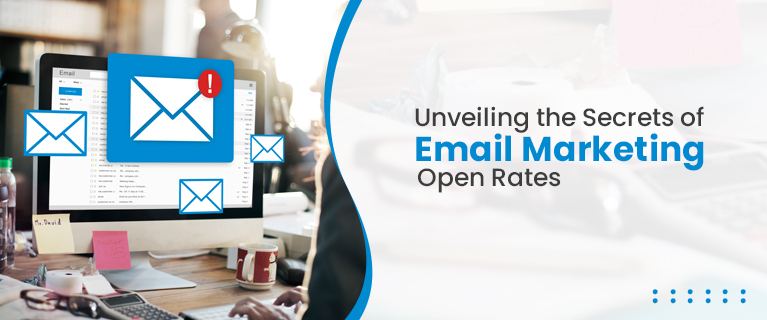Unlocking the secrets of email marketing open rates is paramount to maximizing the success of your campaigns. In today’s digital marketing landscape, where consumers are inundated with messages vying for their attention, understanding the nuances of email engagement is crucial. By delving into data-driven insights, marketers can uncover the optimal day, time, and strategies to enhance engagement and drive conversions.
Read Also This – The Ethical and SEO Considerations of AI-Generated Content
At the heart of effective email marketing lies the open rate – the percentage of recipients who open an email. It serves as a key performance indicator, reflecting the effectiveness of your subject lines, sender reputation, and overall campaign relevance. However, achieving high open rates requires more than crafting compelling content; it demands a nuanced understanding of your audience’s behavior and preferences.
Data analysis plays a pivotal role in deciphering these intricacies. By leveraging analytics tools and metrics, marketers can glean invaluable insights into when their target audience is most active and receptive to emails. This information empowers them to strategically time their campaigns for maximum impact, ensuring that messages are delivered when recipients are most likely to engage.
Read Also This – Navigating the Strategies to Mitigate AI Plagiarism Risks
Furthermore, understanding the relationship between open rates and various factors such as subject line length, personalization, and content relevance enables marketers to fine-tune their strategies for optimal results. A concise, attention-grabbing subject line can significantly boost open rates, while personalized content tailored to the recipient’s interests fosters a sense of connection and relevance.
Moreover, segmentation and targeting are indispensable tactics for improving open rates and overall campaign performance. By segmenting your email list based on demographics, behavior, or purchase history, you can tailor your messages to resonate with specific audience segments, increasing the likelihood of engagement and conversions.
Read Also This – Google’s Revised SEO Starter Guide
Beyond timing and content optimization, monitoring and experimentation are essential components of effective email marketing strategies. Continuously tracking and analyzing performance metrics allows marketers to identify trends, iterate on successful tactics, and course-correct when necessary. A/B testing various elements such as subject lines, send times, and call-to-action buttons enables marketers to refine their approach and unlock further improvements in open rates and overall campaign effectiveness.
In short, email marketing open rates are a window into the effectiveness of your campaigns, offering valuable insights that can drive engagement and conversions. By embracing data-driven strategies, experimenting with different tactics, and staying attuned to audience preferences, marketers can unlock the secrets to achieving sustained success in the ever-evolving landscape of email marketing.
Why Open Rates Matter?
In the intricate realm of email marketing, the open rate stands as a pivotal metric, indicating the percentage of subscribers who engage with your content. A deeper understanding of open rates offers invaluable insights into various aspects of your campaign:
Read Also This – Beyond Click-Through Rate in PPC Marketing
- Subject Line Performance: High open rates signify compelling subject lines that capture recipients’ attention.
- Timing Relevance: Optimal open rates highlight the ideal days and times for email dispatch, ensuring maximum receptivity.
- Segmentation Effectiveness: Effective segmentation tailored to recipients’ preferences is reflected in elevated open rates.
- Customer Engagement: Open rates also unveil customer fatigue or dissatisfaction, prompting reassessment of content relevance.
Insights on Email Marketing Open Rates:
Drawing from a comprehensive survey conducted by our marketing team, insights shed light on the dynamics shaping email engagement:
1. Subject Line Performance:
High open rates indicate that the subject lines are compelling enough to capture recipients’ attention amidst the deluge of emails in their inbox. Compelling subject lines often evoke curiosity, offer value, or create a sense of urgency, prompting recipients to open the email to learn more. Marketers can optimize subject line performance by testing different approaches, such as using personalized language, emojis, or teasing the content inside the email.
Read Also This – Digital Marketing Success With A Monthly Newsletter Guide
2. Timing Relevance:
Optimal open rates reveal the ideal days and times for sending emails when recipients are most likely to be receptive. This can vary depending on factors such as industry, target audience demographics, and geographic location. Analyzing open rates over time allows marketers to identify patterns and determine the most effective send times. Additionally, considering time zones and scheduling emails accordingly can further enhance timing relevance and maximize engagement.
3. Segmentation Effectiveness:
Effective segmentation involves dividing the email list into smaller, targeted groups based on factors such as demographics, behavior, or past interactions. Elevated open rates among segmented groups indicate that the content is tailored to recipients’ preferences and interests. By delivering relevant content to specific segments, marketers can increase engagement and foster a stronger connection with their audience. Segmentation allows for more personalized communication, which often leads to higher open rates and improved overall campaign performance.
Read Also This – Google AdMob’s Technical Ad Delivery Solution
4. Customer Engagement:
Open rates also serve as a barometer of customer engagement and satisfaction. A decline in open rates may indicate recipient fatigue or disinterest in the content being delivered. It could signal that the emails are not resonating with the audience or that they perceive the content as irrelevant. Monitoring changes in open rates over time can help marketers identify trends and potential issues, prompting them to reassess their email content, segmentation strategies, or overall messaging approach. By staying responsive to shifts in open rates, marketers can maintain and enhance customer engagement levels, ultimately driving better campaign outcomes.
In summary, each of these factors plays a crucial role in determining the success of an email marketing campaign. By analyzing open rates in conjunction with these key performance indicators, marketers can gain valuable insights into their audience’s preferences and behavior, enabling them to optimize their strategies for maximum impact and effectiveness.
Leveraging AI and Personalized Insights:
While AI tools offer efficiency gains, judicious utilization is paramount to maintaining customer trust and engagement. Strategic integration of AI, coupled with human finesse, can optimize email copywriting while preserving authenticity.
Read Also This – A Comprehensive Guide to Mastering YouTube Advertising
- Balanced Approach: Marketers leveraging AI for a portion of their copy witness favorable unsubscribe rates, underscoring the viability of a balanced AI-human collaboration.
- Customization and Iteration: Continuous monitoring of metrics and A/B testing enables personalized optimization, ensuring alignment with evolving audience preferences and industry trends.
Elevating Engagement Beyond Open Rates:
Beyond open rates, maximizing click-to-open rates (CTOR) is pivotal in gauging content relevance and engagement. Incorporating interactive elements such as polls, static images, and videos enhances CTOR, fostering deeper audience interaction and brand resonance.
Implementing Data-Driven Strategies:
By deciphering the nuances of email marketing metrics and harnessing data-driven insights, marketers can refine their strategies, foster stronger audience connections, and propel campaign success in a dynamic digital marketing landscape. Utilizing AI tools judiciously, conducting rigorous A/B testing, and embracing personalized optimization are key tenets of a robust email marketing strategy poised for sustained growth and engagement.
The Significance of Open Rates:
Open rates serve as a barometer of email campaign effectiveness, offering valuable insights into recipient engagement and content resonance. A nuanced understanding of open rates empowers marketers to tailor their strategies for optimal impact, leveraging data-driven insights to refine timing, content, and segmentation tactics.
Uncovering Optimal Sending Times:
The timing of email dispatch plays a pivotal role in maximizing open rates. Analyzing data trends and consumer behaviors reveals patterns that inform strategic decisions regarding the best days and times for email delivery. While Wednesday emerges as a frontrunner for overall open rates, industry-specific nuances necessitate tailored approaches to optimize engagement.
Navigating Industry Dynamics:
The B2B and B2C sectors exhibit distinct patterns in email engagement, underscoring the importance of industry-specific insights. For B2C businesses, leveraging Mondays and Tuesdays aligns with consumer purchasing behaviors and fresh start mindsets. Conversely, B2B enterprises witness heightened engagement midweek, reflecting professional routines and receptivity.
Crafting Compelling Subject Lines
Subject lines serve as gateways to email content, exerting a profound influence on open rates. Promotional subject lines and question-based prompts emerge as frontrunners, tapping into recipients’ curiosity and emotional triggers. However, the judicious use of emojis warrants careful consideration, as their impact on open rates varies across demographic segments.
Harnessing the Power of AI
Artificial intelligence offers transformative potential in email marketing, streamlining content creation and personalization. While AI tools enhance efficiency, striking a balance between automation and human touch is crucial to preserving authenticity and fostering audience trust. Marketers embracing AI-driven strategies witness favourable outcomes when complemented by human oversight and strategic refinement.
Optimizing Engagement Beyond Opens
While open rates provide valuable insights, maximizing click-to-open rates (CTOR) is instrumental in gauging content relevance and driving actionable engagement. Interactive elements such as polls, images, and videos enrich email content, fostering deeper audience interaction and brand affinity.
Iterative Optimization and Continuous Improvement:
Achieving email marketing excellence hinges on iterative optimization and data-driven refinement. Monitoring key metrics, conducting A/B testing, and leveraging customer feedback facilitate continuous improvement and adaptive strategies aligned with evolving audience preferences.
Conclusion:-
In an ever-evolving digital landscape, data-driven insights are instrumental in shaping email marketing success. By harnessing the power of analytics, strategic timing, compelling content, and personalized experiences, marketers can forge deeper connections with their audience, drive engagement, and achieve sustainable growth in an increasingly competitive marketplace.



